Beko FS127940N User Manual

Refrigerator
User manual
Gefrierschrank
Bedienungsanleitung
Diepvriezer
Gebruiksaanwijzing
Réfrigérateur
Manuel d'utilisation
FS 127940N
EN / DE / NL / FR
58 4238 0000/AB

Please read this user manual first!
Dear Customer,
We hope that your product, which has been produced in modern plants and checked under the most meticulous quality control procedures, will provide you an effective service.
Therefore, read this entire user manual carefully before using the product and keep it as a reference. If you handover the product to someone else, give the user manual as well.
The user manual will help you use the product in a fast and safe way.
•Read the manual before installing and operating the product.
•Make sure you read the safety instructions.
•Keep the manual in an easily accessible place as you may need it later.
•Read the other documents given with the product.
Remember that this user manual is also applicable for several other models. Differences between models will be identified in the manual.
Explanation of symbols
Throughout this user manual the following symbols are used:
CImportant information or useful tips.
AWarning against dangerous conditions for life and property. BWarning against electric voltage.
2 EN

CONTENTS
1 Your refrigerator |
4 |
2 Safety and Environment |
|
Instructions |
5 |
General Safety ............................................ |
5 |
Intended Use ............................................... |
8 |
Child Safety .................................................. |
8 |
Compliance with WEEE Directive and |
|
Disposing of the Waste Product ......... |
8 |
Compliance with RoHS Directive......... |
8 |
Package Information ................................ |
8 |
3 Installation |
9 |
Points to be paid attention to when the |
|
relocation of the refrigerator ............... |
9 |
Electrical connection ............................... |
9 |
Disposing of the packaging................. |
10 |
Disposing of your old refrigerator .... |
10 |
Placing and Installation......................... |
10 |
Adjusting the legs ................................... |
11 |
4 Preparation |
12 |
Reversing the doors |
............................... 13 |
5 Using your cooler/freezer14
Setting the operating temperature. 14 |
|
Freezing....................................................... |
15 |
Defrosting of the appliance ................ |
16 |
6 Maintenance and cleaning18
Protection of plastic surfaces |
...........18 |
7 Troubleshooting |
19 |
3 EN
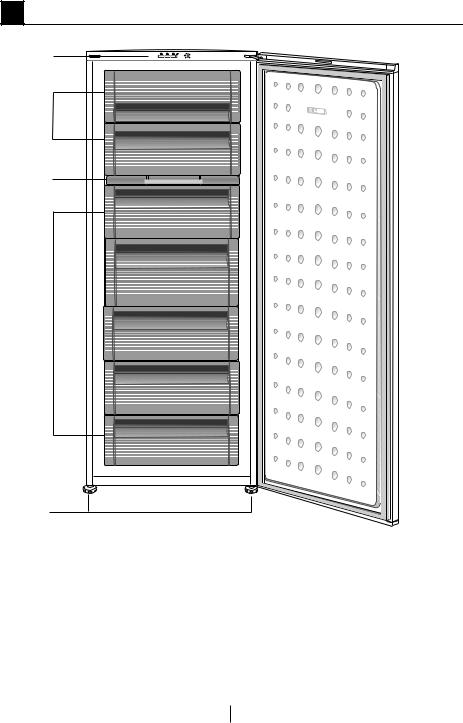
1 Your refrigerator
1
2
3
4
5
1.Control Panel
2.Flap (Fast-Freeze compartment)
3.Ice cube tray & Ice bank
4.Drawers
5.Adjustable front feet
CFigures that take place in this instruction manual are schematic and may not correspond exactly with your product. If the subject parts are not included in the product you have purchased, then it is valid for other models.
4 EN

2 Safety and Environment Instructions
This section provides the safety instructions necessary to prevent the risk of injury and material damage. Failure to observe these instructions will invalidate all types of product warranty.
Intended use
WARNING:
Keep ventilation openings, A in the appliance enclosure or in the built-instructure, clear
of obstruction.
WARNING:
Do not use mechanical devices or other
A means to accelerate the defrostingprocess, other than those recommended by the manufacturer.
WARNING:
A Do not damage the refrigerant circuit.
WARNING:
Do not use electrical appliances inside the food A storage compartments of the appliance, unless they are of the type recommended by the
manufacturer.
WARNING:
A |
Do |
not |
store |
explosive |
substances such as aerosol |
||||
|
cans |
with |
a |
flammable |
|
propellant in this appliance. |
|||
This appliance is intended to be used in household and similar applications such as
–staff kitchen areas in shops, offices and other working environments;
–farm houses and by clients in hotels, motels and other residential type environments;
–bed and breakfast type environments;
–catering and similar non-retail applications.
General Safety
•This product should not be used by persons with physical, sensory and mental disabilities,
without sufficient knowledge and experience or by children. The device can only be used by such persons under supervision and instruction of a person responsible for their safety. Children should not be allowed to play with this device.
•In case of malfunction, unplug the device.
•After unplugging, wait at least 5 minutes before plugging in again.
•Unplug the product when not in use.
•Do not touch the plug with wet hands! Do not pull the cable to plug off, always hold the plug.
•Do not plug in the refrigerator if the socket is loose.
•Unplug the product during installation, maintenance, cleaning and repair.
•If the product will not be used for a while, unplug the product and remove any food inside.
5 EN

•Do not use the product when the compartment with circuit cards located on the upper back part of the product (electrical card box cover) (1) is open.
1
1 |
•Do not use steam or steamed cleaning materials for cleaning the refrigerator and melting the ice inside. Steam may contact the electrified areas and cause short circuit or electric shock!
•Do not wash the product by spraying or pouring water on it! Danger of electric shock!
•In case of malfunction, do not use the product, as it may cause electric shock. Contact the authorized service before doing anything.
•Plug the product into an earthed socket. Earthing must be done by a qualified electrician.
•If the product has LED type lighting, contact the authorized service for replacing or in case of any problem.
•Do not touch frozen food with wet hands! It may adhere to your hands!
•Do not place liquids in bottles and cans into the freezer compartment. They may burst out!
•Place liquids in upright position after tightly closing the lid.
6
•Do not spray flammable substances near the product, as it may burn or explode.
•Do not keep flammable materials and products with flammable gas (sprays, etc.) in the refrigerator.
•Do not place containers holding liquids on top of the product. Splashing water on an electrified part may cause electric shock and risk of fire.
•Exposing the product to rain, snow, sunlight and wind will cause electrical danger. When relocating the product, do not pull by holding the door handle. The handle may come off.
•Take care to avoid trapping any part of your hands or body in any of the moving parts inside the product.
•Do not step or lean on the door, drawers and similar parts of the refrigerator. This will cause the product to fall down and cause damage to the parts.
•Take care not to trap the power cable.
•When positioning the appliance, ensure the supply cord is not trapped or damaged.
•Do not locate multiple portable socket-outlets or portable power
EN supplies at the rear of the appliance.

•Children aged from 3 to 8 years are allowed to load and unload refrigerating appliances.
•To avoid contamination of food, please respect the following instructions:
•– Opening the door for long periods can cause a significant increase of the temperature in the compartments of the appliance.
•– Clean regularly surfaces that can come in contact with food and accessible drainage systems.
•– Clean water tanks if they have not been used for 48 h; flush the water system connected to a water supply if water has not been drawn for 5 days.
•– Store raw meat and fish in suitable containers in the refrigerator, so that it is not in contact with or drip onto other food.
•– Two-star frozen-food compartments are suitable for storing pre-frozen food, storing or making icecream and making ice cubes.
•– One-, twoand three-star compartments are not suitable for the freezing of fresh food.
•– If the refrigerating appliance is left empty for long periods, switch off, defrost, clean, dry, and leave the door open to prevent mould developing within the appliance.
1.1.1 HC Warning
If the product comprises a cooling system using R600a gas, take care to avoid damaging the cooling system and its pipe while using and moving the product. This gas is flammable. If the cooling system is damaged, keep the product away from sources of fire and ventilate the room immediately.
The label on the inner left
Cside indicates the type of gas used in the product.
1.1.2 For Models with Water Dispenser
•Pressure for cold water inlet shall be maximum 90 psi (6.2 bar). If your water pressure exceeds 80 psi (5.5 bar), use a pressure limiting valve in your mains system. If you do not know how to check your water pressure, ask for the help of a professional plumber.
•If there is risk of water hammer effect in your installation, always use a water hammer prevention equipment in your installation. Consult Professional plumbers if you are not sure that there is no water hammer effect in your installation.
•Do not install on the hot water inlet. Take precautions against of the risk of freezing of the hoses. Water
temperature operating interval shall be 33°F (0.6°C) minimum and 100°F (38°C) maximum.
•Use drinking water only.
7 EN

Intended Use
•This product is designed for home use. It is not intended for commercial use.
•The product should be used to store food and beverages only.
•Do not keep sensitive products requiring controlled temperatures (vaccines, heat sensitive medication, medical supplies, etc.) in the refrigerator.
•The manufacturer assumes no responsibility for any damage due to misuse or mishandling.
•Original spare parts will be provided for 10 years, following the product purchasing date.
Child Safety
•Keep packaging materials out of children’s reach.
•Do not allow the children to play with the product.
•If the product’s door comprises a lock, keep the key out of children’s reach.
Compliance with WEEE Directive and Disposing of the Waste Product
This product complies with EU WEEE Directive (2012/19/EU). This product bears a classification symbol for waste electrical and electronic equipment (WEEE).
This product has been manufactured with high quality parts and materials which can be reused and
are suitable for recycling. Do not dispose of the waste product with normal domestic and other wastes at the end of its service life. Take it to the collection center for the recycling of electrical and electronic equipment. Please consult your local authorities to learn about these collection centers.
Compliance with RoHS Directive
•This product complies with EU WEEE Directive (2011/65/EU). It does
not contain harmful and prohibited materials specified in the Directive.
Package Information
Packaging materials of the product are manufactured from recyclable materials in accordance with our National Environment Regulations. Do not dispose of the packaging materials together with the domestic or other wastes. Take them to the packaging material collection points designated by the local authorities.
8 EN
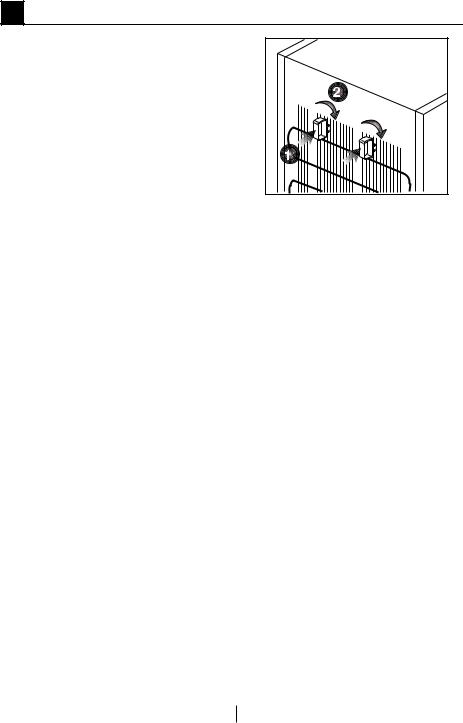
3 Installation
BIn case the information which are given in the user manual are not taken into account, manufacturer will not assume any liability for this.
Points to be paid attention to when the relocation of the refrigerator
1.Your refrigerator should be unplugged.Before transportation of your refrigerator, it should be emptied and cleaned.
2.Before it is re-packaged, shelves, accessories, crisper, etc. inside your refrigerator should be fixed with adhesive tape and secured against impacts. Package should be bound with a thick tape or sound ropes and the transportation rules on the package should be strictly observed.
3.Original packaging and foam materials should be kept for future transportations or moving.
Before you start the refrigerator,
Check the following before you start to use your refrigerator:
1.Attach 2 plastic wedges as illustrated below. Plastic wedges are intended to keep the distance which will ensure the air circulation between your refrigerator and the wall. (The picture is drawn up as a representation and it is not identical with your product.)
2.Clean the interior of the refrigerator as recommended in the “Maintenance and cleaning” section.
3.Connect the plug of the refrigerator to the wall socket. When the fridge door is opened, fridge
internal lamp will turn on. |
9 |
|
4.When the compressor starts to operate, a sound will be heard. The liquid and gases sealed within the refrigeration system may also give rise to noise, even if the compressor is not running and this is quite normal.
5.Front edges of the refrigerator may feel warm. This is normal. These areas are designed to be warm to avoid condensation.
Electrical connection
Connect your product to a grounded socket which is being protected by a fuse with the appropriate capacity.
Important:
The connection must be in compliance with national regulations.
•The power plug must be easily accessible after installation.
•Electrical safety of your refrigerator shall be guaranteed only if the earth system in your house complies with standards.
•The voltage stated on the label located at left inner side of your product should be equal to your network voltage.
•Extension cables and multi plugs must not be used for connection.
EN

BA damaged power cable must be replaced by a qualified electrician.
BProduct must not be operated before it is repaired! There is the risk of electric shock!
Disposing of the packaging
The packing materials may be dangerous for children. Keep the packing materials out of the reach of children or dispose of them by classifying them in accordance with the waste instructions stated by your local authorities. Do not throw away with regular house waste, throw away on packaging pick up spots designated by the local authorities.
The packing of your refrigerator is produced from recyclable materials.
Disposing of your old refrigerator
Dispose of your old refrigerator without giving any harm to the environment.
•You may consult your authorized dealer or waste collection center of your municipality about the disposal of your refrigerator.
Before disposing of your refrigerator, cut out the electric plug and, if there are any locks on the door, make them inoperable in order to protect children against any danger.
10
Placing and Installation
A If the entrance door of the room where the refrigerator will be installed is not wide enough for the refrigerator to pass through, then call the authorized service to have them remove the doors of your refrigerator and pass it sideways through the door.
1.Install your refrigerator to a place that allows ease of use.
2.Keep your refrigerator away from heat sources, humid places and direct sunlight.
3.There must be appropriate air ventilation around your refrigerator in order to achieve an efficient operation. If the refrigerator is to be placed in a recess in the wall, there must be at least 5 cm distance with the ceiling and at least 5 cm with the wall. Do not place your product on the materials such as rug or carpet.
4.Place your refrigerator on an even floor surface to prevent jolts.
5.Your product requires adequate air circulation to function efficiently. If the product will be placed in an alcove, remember to leave at least 5 cm clearance between the product and the ceiling, rear wall and the side walls.
6.If the product will be placed
in an alcove, remember to leave at least 5 cm clearance between the product and the ceiling, rear wall and the side walls. Check if the rear wall clearance protection component is present at its location (if provided with the product). If the component is not available, or if it is lost or fallen, position the product so that at least 5 cm clearance shall be left between the rear surface of the product and the wall of the room. The clearance at the rear is important for efficient ENoperation of the product.

Adjusting the legs
If your refrigerator is unbalanced; You can balance your refrigerator
by turning its front legs as illustrated in the figure. The corner where the leg exists is lowered when you turn in the direction of black arrow and raised when you turn in the opposite direction. Taking help from someone to slightly lift the refrigerator will facilitate this process.
11 EN
4 |
Preparation |
|
|
• |
Your cooler/freezer should be |
°C, frozen food in the freezer does |
|
|
installed at least 30 cm away from |
not thaw thanks to its Advanced |
|
|
heat sources such as hobs, ovens, |
Electronic Temperature Control |
|
|
central heater and stoves and at |
System. For the first installation, the |
|
|
least 5 cm away from electrical |
product should NOT be placed under |
|
|
ovens and should not be located |
low ambient temperatures. This is |
|
|
under direct sunlight. |
because the freezer cannot go down |
|
• Please make sure that the interior |
to standard operation temperature. |
||
|
of your cooler/freezer is cleaned |
When reaching continuous |
|
|
thoroughly. |
operation, the product can be moved |
|
• If two coolers are to be installed side |
to another place. Thus, later you can |
||
place your product in the garage |
|||
|
by side, there should be at least 2 cm |
||
|
or an unheated room without the |
||
|
distance between them. |
||
|
concern of causing frozen food to |
||
• When you operate your cooler/ |
|||
get rotten. However, it is likely that |
|||
|
freezer for the first time, please |
||
|
above mentioned low temperatures |
||
|
observe the following instructions |
||
|
may cause the freezing of the food |
||
|
during the initial six hours. |
||
|
in the fridge compartment; thus, |
||
• Its door should not be opened |
|||
please consume the food items in |
|||
|
frequently. |
the fridge in a controlled way as |
|
• It must be operated empty without |
needed. When ambient temperature |
||
|
placing any food in it. |
goes back to normal, you may |
|
• Do not unplug your cooler/freezer. |
change button setting according to |
||
your need. |
|||
|
If a power failure occurs out of your |
||
|
• If the ambient temperature is |
||
|
control, please see the warnings in |
||
|
the “Recommended solutions for |
below 0°C, the food in fridge |
|
|
the problems” section. |
compartment will freeze. Therefore, |
|
• The baskets/drawers that are |
we recommend not using the fridge |
||
compartment in such low ambient |
|||
|
provided with the chill compartment |
||
|
temperatures. You may continue |
||
|
must always be in use for low energy |
||
|
to use the freezer compartment as |
||
|
consumption and for better storage |
||
|
usual. |
||
|
conditions. |
||
|
• In some models, the instrument |
||
• Food contact with the temperature |
|||
panel automatically turns off 5 |
|||
|
sensor in the freezer compartment |
||
|
minutes after the door has closed. |
||
|
may increase energy consumption |
||
|
It will be reactivated when the door |
||
|
of the appliance. Thus any contact |
||
|
has opened or pressed on any key. |
||
|
with the sensor(s) must be avoided. |
||
|
• Due to temperature change as |
||
• This product has been designed to |
|||
a result of opening/closing the |
|||
|
function at ambient temperatures |
||
|
product door during operation, |
||
|
up to 43 °C (90 SDgrF). Even if the |
||
|
condensation on the door/body |
||
|
ambient temperature falls to -15 |
||
|
shelves and the glass containers is |
||
12 |
|||
EN normal. |
|||

Reversing the doors
Proceed in numerical order .
12
|
2 |
5 |
|
1 |
3 |
||
|
6
4
45¡
|
8 |
|
7 |
|
|
|
|
9 |
|
16 |
|
|
12 |
13 |
180¡ |
|
20 |
15 |
21 |
|
|
16 |
18 |
17 |
19 |
14
11
10 |
13 EN

5 Using your cooler/freezer
Setting the operating temperature
Warm




 Cold
Cold
The operating temperature is regulated by the temperature control.
1 = Lowest cooling setting (Warmest setting)
MAX. = Highest cooling setting (Coldest setting)
Please choose the setting according to the desired temperature.
The interior temperature also depends on ambient temperature, the frequency with which the door is opened and the amount of foods kept inside.
Frequently opening the door causes the interior temperature to rise.
For this reason, it is recommended to close the door again as soon as possible after use.
The normal storage temperature of your appliance should be -18 °C (0 °F). Lower temperatures can be obtained by adjusting the thermostat knob towards Position MAX.
We recommend checking the temperature with a thermometer to ensure that the storage compartments are kept to the desired temperature. Remember to take the reading immediately since the thermometer temperature will rise very rapidly after you remove it from the freezer.
14 EN
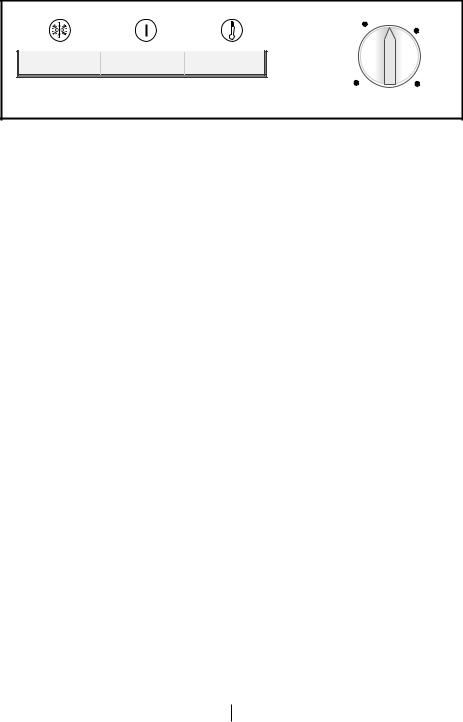
3 |
4 |
|
2 
1 |
MAX. |
Indicator lights
There are three coloured indicator lights located inside the appliance which show the operating mode of the freezer.
Amber Indicator
Illuminates when the thermostat knob is turned to MAX. position and stays on until the fast freeze operation is deactivated manually.
Fast-freeze operation is for freezing fresh food.
Green Indicator
Illuminates when the appliance is connected to the mains and will glow as long as there is electricity present. The green indicator does not give any indication of the temperature inside the freezer.
Red Indicator High Temperature Alarm
After the appliance is turned on for the first time the alarm is not active for 12 hours (The red LED indicator is switched off).
After this period of time the red LED indicator is switched on in the
following situations:
-If the appliance is overloaded with fresh food -If the door is left open
by mistake.In these situations the red LED indicator will continue to be switched on until the appliance reaches the preset temperature. If the red LED indicator is still switched on then wait for 24 hours before calling
service. |
15 |
|
Thermostat knob
The thermostat knob is located on the indicator light frame.
Important:
When you press the fast-freeze switch or adjust the set temperature, there may be a short delay before the compressor starts to operate. This is normal and not a compressor fault.
Freezing
Freezing food
You can use the appliance for freezing fresh food as well as for storing pre-frozen food.
Please refer to the recommendations given on the packaging of your food.
• Attention
Do not freeze fizzy drinks, as the bottle may burst when the liquid in it is frozen.
Be careful with frozen products such as coloured ice-cubes.
Do not exceed the freezing capacity of your appliance in 24 hours. See the rating label.
In order to maintain the quality of the food, the freezing must be effected as
EN

rapidly as possible.
Thus, the freezing capacity will not be exceeded, and the temperature inside the freezer will not rise.
• Attention
Keep the already deep-frozen food always separated with freshly placed food.
When deep-freezing hot food, the cooling compressor will work until the food is completely frozen. This can temporarily cause excessive cooling of the refrigeration compartment.
If you find the freezer door difficult to open just after you have closed it, don’t worry. This is due to the pressure difference which will equalize and allow the door to open normally after a few minutes.
You will hear a vacuum sound just after closing the door. This is quite normal.
Fast freeze
If large amounts of fresh food are going to be frozen, adjust the control knob to max. 24 hours before putting the fresh food in the fast freeze compartment.
It is strongly recommended to keep the knob at MAX. position at least 24 hours to freeze maximum amount of fresh food declared as freezing capacity. Take special care not to mix frozen food and fresh food.
Remember to turn the thermostat knob back to its previous position once food has frozen.
Defrosting of the appliance
Excessive build-up of ice will affect the freezing performance of your appliance.
It is therefore recommended that you defrost your appliance at least twice a year, or whenever the ice build-up exceeds 7 mm.
Defrost your appliance when there is only little or no food in it.
Take out the deep-frozen food from the drawers. Wrap the deep-frozen food in several layers of paper, or a blanket, and keep it in a cold place.
Unplug the appliance or switch off the circuit breaker to start the defrosting process.
Take out the accessories (like shelf, drawer etc.) from the appliance and use a suitable container to collect the thawing water.
Use a sponge or a soft cloth to remove
thawing water if necessary.
Keep the door open during defrosting.
For quicker defrosting, place containers with warm water inside the appliance.
Never use electrical devices, defrosting sprays or pointed or sharpedged objects such as knives or forks
16 EN

to remove the ice.
After the defrosting is done, clean the inside (see the section ‘Cleaning and care’).
Reconnect the appliance to the mains. Place the frozen food into the drawers and slide the drawers into the freezer.
17 EN

6 Maintenance and cleaning
ANever use gasoline, benzene or similar substances for cleaning purposes.
BWe recommend that you unplug the appliance before cleaning.
BNever use any sharp abrasive instrument, soap, household cleaner, detergent and wax polish for cleaning.
BFor non-No Frost products, water drops and frosting up to a
fingerbreadth occur on the rear wall of the Fridge compartment. Do not clean it; never apply oil or similar agents on it.
BOnly use slightly damp microfiber cloths to clean the outer surface of the product. Sponges and other
types of cleaning cloths may scratch the surface.
CUse lukewarm water to clean the cabinet of your refrigerator and wipe it dry.
CUse a damp cloth wrung out in a solution of one teaspoon of
bicarbonate of soda to one pint of water to clean the interior and wipe it dry.
BMake sure that no water enters the lamp housing and other electrical items.
BIf your refrigerator is not going to be used for a long period of time, unplug the power cable, remove all
food, clean it and leave the door ajar.
CCheck door seals regularly to ensure they are clean and free from food particles.
ATo remove door racks, remove all the contents and then simply push the door rack upwards from the base.
ANever use cleaning agents or water that contain chlorine to clean the outer surfaces and chromium coated parts of the product. Chlorine causes corrosion on such metal surfaces.
ADo not use sharp, abrasive tools, soap, household cleaning agents, detergents, kerosene, fuel oil, varnish etc. to prevent removal and deformation of the prints on the plastic part. Use lukewarm water and a soft cloth for cleaning and then wipe it dry.
Protection of plastic surfaces
CDo not put the liquid oils or oilcooked meals in your refrigerator in unsealed containers as they
damage the plastic surfaces of your refrigerator. In case of spilling or smearing oil on the plastic surfaces, clean and rinse the relevant part
of the surface at once with warm water.
18 EN

7 Troubleshooting
Please review this list before calling the service. It will save your time and money. This list includes frequent complaints that are not arising from defective workmanship or material usage. Some of the features described here may not exist in your product.
The refrigerator does not operate.
•The plug is not inserted into the socket correctly. >>>Insert the plug into the socket securely.
•The fuse of the socket which your refrigerator is connected to or the main fuse have blown out. >>>Check the fuse.
Condensation on the side wall of the fridge compartment (MULTIZONE, COOL CONTROL and FLEXI ZONE).
•Door has been opened frequently. >>>Do
not open and close the door of refrigerator frequently.
•Ambient is very humid. >>>Do not install your refrigerator into highly humid places.
•Food containing liquid is stored in open containers. >>>Do not store food with liquid content in open containers.
•Door of the refrigerator is left ajar.
>>>Close the door of the refrigerator.
•Thermostat is set to a very cold level.
>>>Set the thermostat to a suitable level.
Compressor is not running
•Protective thermic of the compressor will blow out during sudden power failures or plug-out plug-ins as the refrigerant pressure in the cooling system of the refrigerator has not been balanced yet. The refrigerator will start running approximately after 6 minutes. Please call the service if the refrigerator does not startup at the end of this period.
•The fridge is in defrost cycle. >>>This is normal for a full-automatically defrosting refrigerator. Defrosting cycle occurs periodically.
•The refrigerator is not plugged into the socket. >>>Make sure that the plug is fit into the socket.
•Temperature settings are not made correctly. >>>Select the suitable temperature value.
•There is a power outage. >>>Refrigerator
returns to normal operation when the power restores.
The operation noise increases when the refrigerator is running.
• The operating performance of the refrigerator may change due to the changes in the ambient temperature. It is normal and not a fault.
19 EN

The refrigerator is running frequently or for a long time.
•New product may be wider than the previous one. Larger refrigerators operate for a longer period of time.
•The room temperature may be high.
>>>It is normal that the product operates for longer periods in hot ambient.
•The refrigerator might be plugged in recently or might be loaded with food.
>>>When the refrigerator is plugged in or loaded with food recently, it will take longer for it to attain the set temperature. This is normal.
•Large amounts of hot food might be put in the refrigerator recently. >>>Do not put hot food into the refrigerator.
•Doors might be opened frequently or left ajar for a long time. >>>The warm air that has entered into the refrigerator causes the refrigerator to run for longer periods. Do not open the doors frequently.
•Freezer or fridge compartment door might be left ajar. >>>Check if the doors are closed completely.
•The refrigerator is adjusted to a very low temperature. >>>Adjust the refrigerator temperature to a warmer degree and wait until the temperature is achieved.
• Door seal of the fridge or freezer may be soiled, worn out, broken or not properly seated. >>>Clean or replace the seal. Damaged/broken seal causes the refrigerator to run for a longer period of time in order to maintain the current temperature.
Freezer temperature is very low while the fridge temperature is sufficient.
• The freezer temperature is adjusted to a very low value. >>>Adjust the freezer temperature to a warmer degree and check.
Fridge temperature is very low while the freezer temperature is sufficient.
• The fridge temperature is adjusted to a very low value. >>>Adjust the fridge temperature to a warmer degree and check.
Food kept in the fridge compartment drawers is frozen.
• The fridge temperature is adjusted to a very high value. >>>Adjust the fridge temperature to a lower value and check.
Temperature in the fridge or freezer is very high.
•The fridge temperature is adjusted to a very high value. >>>Fridge compartment temperature setting has an effect on the temperature of the freezer. Change the temperatures of the fridge or freezer and wait until the relevant compartments attain a sufficient temperature.
•Doors are opened frequently or left ajar for a long time. >>>Do not open the doors frequently.
•Door is ajar. >>>Close the door completely.
•The refrigerator is plugged in or loaded with food recently. >>>This is normal. When the refrigerator is plugged in or loaded with food recently, it will take longer for it to attain the set temperature.
•Large amounts of hot food might be put in the refrigerator recently. >>>Do not put hot food into the refrigerator.
20 EN

Vibrations or noise.
•The floor is not level or stable. >>> If the refrigerator rocks when moved slowly, balance it by adjusting its feet. Also make sure that the floor is strong enough to carry the refrigerator, and level.
•The items put onto the refrigerator may cause noise. >>>Remove the items on top of the refrigerator.
There are noises coming from the refrigerator like liquid flowing, spraying, etc.
• Liquid and gas flows occur in accordance with the operating principles of your refrigerator. It is normal and not a fault.
Whistle comes from the refrigerator.
• Fans are used in order to cool the refrigerator. It is normal and not a fault.
Condensation on the inner walls of refrigerator.
•Hot and humid weather increases icing and condensation. It is normal and not a fault.
•Doors are opened frequently or left ajar for a long time. >>>Do not open the doors frequently. Close them if they are open.
•Door is ajar. >>>Close the door completely.
Humidity occurs on the outside of the refrigerator or between the doors.
• There might be humidity in the air; this is quite normal in humid weather. When the humidity is less, condensation will disappear.
Bad odour inside the refrigerator.
•No regular cleaning is performed.
>>>Clean the inside of the refrigerator regularly with a sponge, lukewarm water or carbonate dissolved in water.
•Some containers or package materials may cause the smell. >>>Use a different container or different brand packaging material.
•Food is put into the refrigerator in uncovered containers. >>>Keep the food in closed containers. Microorganisms spreading out from uncovered containers can cause unpleasant odours.
•Remove the foods that have expired best before dates and spoiled from the refrigerator.
The door is not closing.
•Food packages are preventing the door from closing. >>>Replace the packages that are obstructing the door.
•The refrigerator is not completely even on the floor. >>>Adjust the feet to balance the refrigerator.
•The floor is not level or strong. >>>Make
sure that the floor is level and capable to carry the refrigerator.
Crispers are stuck.
• The food is touching the ceiling of the drawer. >>>Rearrange food in the drawer.
If The Surface Of The Product Is Hot.
• High temperatures may be observed between the two doors, on the side panels and at the rear grill while the product is operating. This is normal and does not require service maintenance!
21 EN

Bitte lesen Sie zuerst diese Anleitung!
Liebe Kundin, lieber Kunde,
Wir sind sicher, dass Ihnen dieses Produkt, das in modernsten Fertigungsstätten hergestellt und strengsten Qualitätsprüfungen unterzogen wurde, lange Zeit gute Dienste leisten wird.
Daher empfehlen wir Ihnen, vor Inbetriebnahme des Gerätes das gesamte Handbuch durchzulesen und es anschließend aufzubewahren.
Zu dieser Anleitung...
•Die Anleitung hilft Ihnen, Ihr Gerät schnell und sicher zu bedienen.
•Lesen Sie die Anleitung, bevor Sie Ihr Gerät aufstellen und bedienen.
•Halten Sie sich an die Anweisungen, beachten Sie insbesondere die Sicherheitshinweise.
•Bewahren Sie die Anleitung an einem leicht zugänglichen Ort auf, damit Sie jederzeit darin nachschlagen können.
•Lesen Sie auch die weiteren Dokumente, die mit Ihrem Produkt geliefert wurden.
Bitte beachten Sie, dass diese Anleitung eventuell auch für andere Geräte eingesetzt werden kann.
Symbole und ihre Bedeutung
In dieser Anleitung finden Sie die folgenden Symbole:
C Wichtige Informationen oder nützliche Tipps.
AWarnung vor Verletzungen oder Sachschäden.
BWarnung vor elektrischem Strom.
1 DE

INHALT
1 Ihr Kühlschrank / |
|
Gefrierschrank |
3 |
2 Wichtige |
|
Sicherheitshinweise |
4 |
Bestimmungsgemäßer Einsatz.................. |
4 |
Allgemeine Hinweise zu Ihrer Sicherheit ... |
4 |
Bei Geräten mit Wasserspender: .............. |
7 |
Kinder – Sicherheit ................................... |
7 |
Erfüllung von WEEE-Vorgaben zur |
|
Entsorgung von Altgeräten: ..................... |
7 |
Hinweise zur Verpackung ......................... |
8 |
HC-Warnung ............................................ |
8 |
Tipps zum Energiesparen ......................... |
8 |
4 Vorbereitung |
12 |
Türanschlag umkehren |
............................13 |
5 Nutzung des Kühlschrank / Gefrierschranks 14
Einstellen der Betriebstemperatur ........... |
14 |
|
6 |
Wartung und Reinigung |
18 |
Schutz der Kunststoffflächen ................. |
18 |
|
7 |
Empfehlungen zur |
|
Problemlösung |
19 |
|
3 Installation |
9 |
Wenn Sie den Kühlschrank versetzen |
|
möchten:.................................................. |
9 |
Vor dem Einschalten................................. |
9 |
Elektrischer Anschluss.............................. |
9 |
Verpackungsmaterialien entsorgen ......... |
10 |
Altgeräte entsorgen ................................ |
10 |
Aufstellung und Installation ..................... |
10 |
Füße einstellen........................................ |
11 |
2 DE
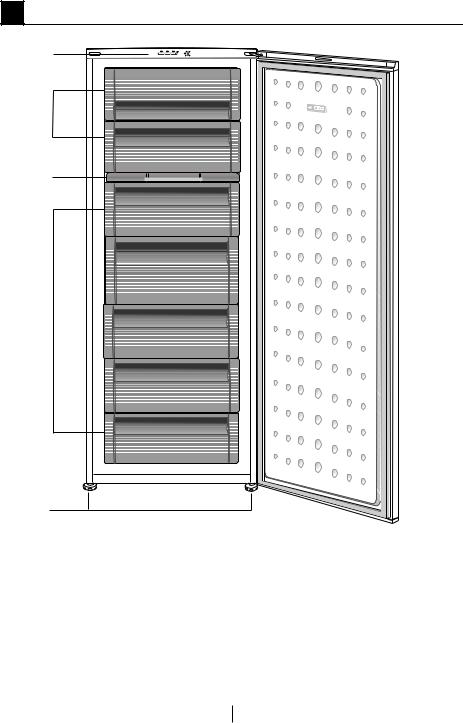
1 Ihr Kühlschrank / Gefrierschrank
1
2
3
4
5
1.Bedienfeld
2.Klappe (Schnellgefrierfach) 3.Eiswürfelschale und Eiswürfelfach 4.Schubladen
5.Einstellbare Füße an der Frontseite
CAbbildungen und Angaben in dieser Anleitung sind schematisch und können etwas von Ihrem Gerät abweichen. Falls Teile nicht zum Lieferumfang des erworbenen Gerätes zählen, gelten sie für andere Modelle.
3 DE
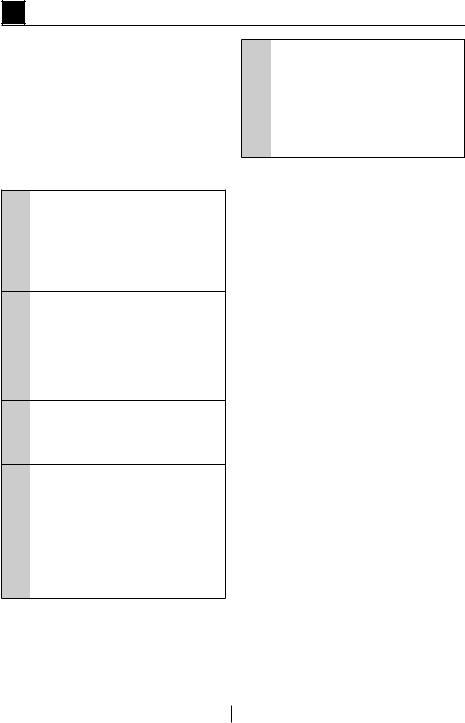
2 Wichtige Sicherheitshinweise
Bitte lesen Sie die folgenden Hinweise aufmerksam durch. Bei Nichtbeachtung dieser Angaben kann es zu Verletzungen und Sachschäden kommen. In diesem Fall erlöschen auch sämtliche Garantieund sonstigen Ansprüche.
Originalersatzteile stehen für einen Zeitraum von 10 Jahre beginnend mit dem Kaufdatum zur Verfügung.
WARNUNG:
Lagern Sie keinerlei explosiven
ASubstanzen (dazu zählen auch Sprühdosen mit brennbarem Treibmittel) im Gerät.
Bestimmungsgemäßer Einsatz
ACHTUNG:
Stellen Sie sicher, dass wenn das
AGerät in seinem
Gehäuse oder platziert ist, die Entlüftungsöffnungen nicht blockiert werden.
ACHTUNG:
Um den Auftauvorgang zu beschleunigen,
Akeine anderen mechanischen Geräte oder Geräte verwenden, die nicht vom Hersteller
empfohlen sind.
ACHTUNG:
Dem Kühlmittelkreislauf keine
ASchäden
zufügen.
ACHTUNG:
In den ebensmittelaufbewahrungsfächern keine
Aelektrischen Geräte verwenden, die nicht vom
Hersteller empfohlen sind.
Dieses Gerät ist für die private Nutzung oder für den Gebrauch bei folgenden ähnlichen Anwendungen konzipiert wurden
-In Personalküchen in Geschäften, Büros und anderen Arbeitsumgebungen;
-In Bauernhöfen, Hotels, Motels und anderen Unterkünften, für den Gebrauch der Kunden;
-Umgebungen mit Übernachtung und Frühstück;
-Bei Catering und ähnlichen Non- Retail-Anwendungen.
Allgemeine Hinweise zu Ihrer Sicherheit
•Wenn Sie das Gerät entsorgen möchten, wenden Sie sich am besten an den autorisierten Kundendienst. Hier erhalten Sie notwendige Informationen und erfahren, welche Stellen für die Entsorgung zuständig sind.
•Bei Problemen und Fragen zum Gerät wenden Sie sich grundsätzlich an den autorisierten Kundendienst. Ziehen Sie keine Dritten zu Rate, versuchen Sie nichts in Eigenregie, ohne den autorisierten Kundendienst davon in Kenntnis zu setzen.
•Bei Geräten mit Tiefkühlbereich: Der Verzehr von Speiseeis und Eiswürfeln unmittelbar nach der Entnahme aus dem Tiefkühlbereich ist nicht ratsam. (Dies kann zu Erfrierungen führen.)
•Bei Geräten mit Tiefkühlbereich: Bewahren Sie Getränke in Flaschen sowie Dosen niemals im Tiefkühlbereich
4 DE

auf. Diese platzen.
•Berühren Sie gefrorene Lebensmittel nicht mit der Hand; sie können festfrieren.
•Trennen Sie Ihren Kühlschrank vor dem Reinigen oder Abtauen vom Stromnetz.
•Verwenden Sie niemals Dampfoder Sprühreiniger zum Reinigen und Abtauen Ihres Kühlschranks. Die Dämpfe oder Nebel können in Kontakt mit stromführenden Teilen geraten und Kurzschlüsse oder Stromschläge auslösen.
•Missbrauchen Sie niemals Teile Ihres Kühlschranks (z. B. Tür) als Befestigungen oder Kletterhilfen.
•Nutzen Sie keine elektrischen Geräte innerhalb des Kühlschranks.
•Achten Sie darauf, den Kühlkreislauf keinesfalls mit Bohroder Schneidwerkzeugen zu beschädigen. Das Kühlmittel kann herausspritzen, wenn die Gaskanäle des Verdunsters, Rohrund Schlauchleitungen oder Oberflächenversiegelungen beschädigt werden. Dies kann zu Hautreizungen und Augenverletzungen führen.
•Decken Sie keinerlei Belüftungsöffnungen des Kühlschranks ab.
•Elektrische Geräte dürfen nur von autorisierten Fachkräften repariert werden. Reparaturen durch weniger kompetente Personen können erhebliche Gefährdungen des Anwenders verursachen.
•Sollten Fehler oder Probleme während der Wartung oder Reparaturarbeiten auftreten, so trennen Sie den Kühlschrank von der Stromversorgung, indem Sie die entsprechende Sicherung abschalten oder den Netzstecker ziehen.
•Ziehen Sie niemals am Netzkabel – ziehen Sie direkt am Stecker.
•Achten Sie darauf, hochprozentige Getränke stehend und mit fest verschlossenem Deckel zu lagern.
•Bewahren Sie niemals Sprühdosen mit brennbaren und explosiven Substanzen im Kühlschrank auf.
•Nutzen Sie keine mechanischen oder anderen Hilfsmittel, um das Gerät abzutauen – es sei denn, solche Hilfsmittel werden ausdrücklich vom Hersteller empfohlen.
•Dieses Produkt darf nicht von Personen (einschließlich Kindern) mit eingeschränkten physischen,
sensorischen oder geistigen Fähigkeiten bedient werden, sofern sie nicht durch eine Person, die für ihre Sicherheit verantwortlich ist, in der Bedienung des Produktes angeleitet werden.
•Nehmen Sie einen beschädigten Kühlschrank nicht in Betrieb. Wenden Sie sich bei jeglichen Zweifeln an einen Kundendienstmitarbeiter.
•Die elektrische Sicherheit des Gerätes ist nur dann gewährleistet, wenn
das hausinterne Erdungssystem den zutreffenden Normen entspricht.
•Setzen Sie das Gerät keinem Regen, Schnee, direktem Sonnenlicht oder Wind aus; dies kann die elektrische Sicherheit gefährden.
•Wenden Sie sich zur Vermeidung von Gefahren an den autorisierten Kundendienst, falls das Netzkabel beschädigt ist.
•Stecken Sie während der Installation niemals den Netzstecker ein. Andernfalls kann es zu schweren bis tödlichen Verletzungen kommen.
•Dieser Kühlschrank dient nur der Aufbewahrung von Lebensmitteln. Für andere Zwecke sollte er nicht verwendet werden.
•Das Etikett mit den technischen Daten befindet sich an der linken Innenwand des Kühlschranks.
•Schließen Sie Ihren Kühlschrank niemals an energiesparende Systeme an; dies kann den Kühlschrank beschädigen.
•Falls sich ein blaues Licht am Kühlschrank befindet, blicken Sie nicht längere Zeit mit bloßem Augen oder optischen Werkzeugen hinein.
5 DE

•Bei manuell gesteuerten Kühlschränken warten Sie mindestens 5 Minuten, bevor Sie den Kühlschrank nach einem Stromausfall wieder einschalten.
•Falls Sie das Gerät an einen anderen Besitzer weitergeben, vergessen Sie nicht, die Bedienungsanleitung ebenfalls auszuhändigen.
•Achten Sie darauf, dass das Netzkabel beim Transport des Kühlschranks nicht beschädigt wird. Übermäßiges Biegen des Kabels birgt Brandgefahr. Platzieren Sie keine schweren Gegenstände auf dem Netzkabel.
•Berühren Sie den Netzstecker niemals mit feuchten oder gar nassen Händen.
•Achten Sie beim Aufstellen des Gerätes darauf, dass das Netzkabel nicht eingeklemmt oder anderweitig beschädigt wird.
•Platzieren Sie nicht mehrere Mehrfachsteckdosen oder Netzteile hinter dem Gerät.Schließen Sie den Kühlschrank nicht an lose Steckdosen an.
•Kinder im Alter von 3 bis 8 Jahren dürfen Kühlgeräte einund ausräumen.
•Vermeiden Sie durch Einhaltung der folgenden Anweisungen Lebensmittelkontamination:
•Durch langes Öffnen der Tür kann die Temperatur in den Fächern des Gerätes drastisch ansteigen.
•Reinigen Sie die Oberflächen, die mit Lebensmitteln in Berührung kommen, sowie zugängliche Ableitungssysteme regelmäßig.
•Reinigen Sie Wassertanks, wenn diese 48 Stunden lang nicht benutzt wurden; spülen Sie das an die Wasserversorgung angeschlossene Wassersystem durch, falls 5 Tage lang kein Wasser entnommen wurde.
•Bewahren Sie rohes Fleisch und Fisch in geeigneten Behältern im Kühlschrank auf, damit diese nicht mit anderen Lebensmitteln in Berührung kommen.
•Zwei-Sterne-Gefrierfächer eignen sich zur Aufbewahrung von Tiefkühlkost, zur Lagerung oder Herstellung von Speiseeis und zur Herstellung von Eiswürfeln.
•Ein-, Zweiund Drei-Sterne-Fächer eignen sich nicht zum Einfrieren frischer Lebensmittel.
•Falls das Kühlgerät lange Zeit leer bleibt, sollten Sie es abschalten, abtauen, reinigen, trocknen und die
•Tür geöffnet lassen, damit sich kein Schimmel im Gerät bildet.
•Sprühen Sie aus Sicherheitsgründen niemals Wasser auf die Innenund Außenflächen des Gerätes.
•Sprühen Sie keine Substanzen mit brennbaren Gasen, wie z. B. Propangas, in die Nähe des Kühlschranks; andernfalls bestehen Brandund Explosionsgefahr.
•Stellen Sie keine mit Wasser gefüllten Gegenstände auf den Kühlschrank; dies birgt Brandund Stromschlaggefahr.
•Überladen Sie das Gerät nicht mit Lebensmitteln. Wenn das Gerät überladen ist, können beim Öffnen der Kühlschranktür Lebensmittel herausfallen und Verletzungen verursachen.
•Stellen Sie keinesfalls Gegenstände auf den Kühlschrank; sie könnten beim
Öffnen oder Schließen der Kühlschranktür herunterfallen.
•Materialien wie beispielsweise Impfstoffe, wärmeempfindliche Arznei, wissenschaftliche Proben usw. sollten nicht im Kühlschrank aufbewahrt werden, da sie bei exakt festgelegten Temperaturen gelagert werden müssen.
6 DE
